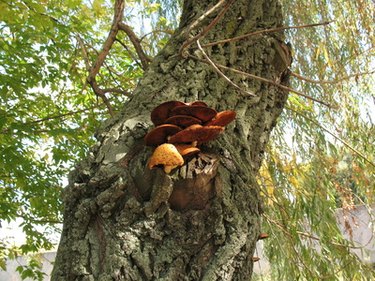
Mushrooms and other fungi are a common sight on dead and decaying trees. Some kinds of fungus also grow on the trunks of live trees, or on decks, houses and other wooden structures. All fungi are decomposers, which help break down plant material into fertile soil. Even if you can't see a mushroom growing, there's a good chance any fallen piece of wood already contains a fungus.
Decomposition
Video of the Day
Mushrooms growing on a tree or log may be unattractive to look at, but they are actually performing an important job. Without mushrooms and other decomposers, dead wood would never rot. Wood mushrooms grow best in warm, damp conditions, and may not do as well when the weather is cool or dry. These fungi also prefer food containing plenty of nitrogen, since this element helps them grow faster and larger.
Video of the Day
Wood Mushrooms
Some wood fungi take the traditional mushroom or toadstool form when they fruit. These include such species as sulfur tuft, a small yellow to green mushroom that prefers fallen logs; honey mushroom, a light brown edible species native to the northwestern United States; golden pholiota, a slimy yellow genus of mushrooms; and jelly fungi, translucent yellow funnel or toadstool-shaped fungi that prefer dead branches. Shiitake mushrooms, popular in Asian cuisine, also grow on logs. Bird's nest fungi, cup mushrooms and morels grow near dead wood, but don't look like conventional mushrooms.
Shelf Fungi
Shelf fungi are a specialized type of fungus that grows on both living and dead trees. These include edible species like the oyster mushroom, cloud or wood ear fungus and hen of the woods. Other shelf fungi include the artist's conk, which can affect wounded living trees; varnish fungus rot; hairy turkey tail, which attacks dead wood in living trees, and turkey tail fungus, which attacks both fallen wood and wounded live trees. Some of these fungi are harmless to living trees, while others can rot the inside of any tree they attach to. Any fungi on a landscape tree indicate an injury or dead wood, and should be treated.
Misconceptions
Some people believe that all mushrooms or fungi found growing on wood are safe to eat. While many edible mushrooms do prefer fallen logs and other wood, a number of inedible or poisonous species also grow in these habitats. Never eat a mushroom unless you are absolutely sure it's safe. Eat only a small amount the first time you try a mushroom, in case you misidentify a specimen, or you have a reaction to that species.
- Ohio State University; Wild Mushrooms; C. Wayne Ellett
- Utah State University; Waste Not, Want Not: Fungi as Decomposers
- University of Wisconsin; Pleurotus Osteratus; Tom Volk; October 1998
- Utah State University: Shelf Fungi
- University of California; Wood Decay Fungi in Landscape Trees; G. W. Hickman et al; March 2003
- “A Field Guide to the Lowland Northwest”; Mushrooms Growing on Logs; Rob Sandelin